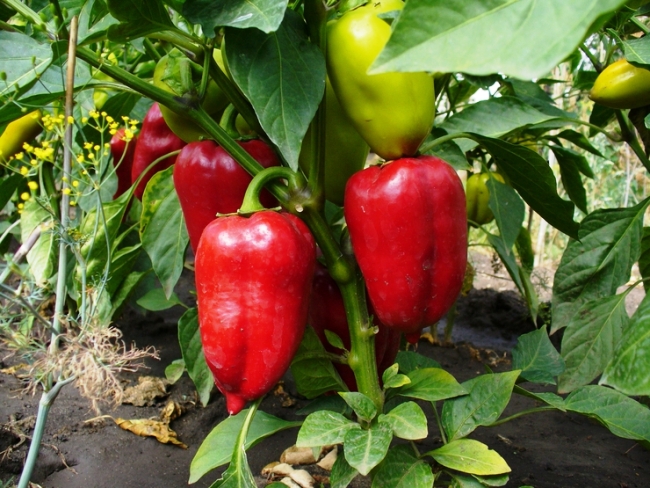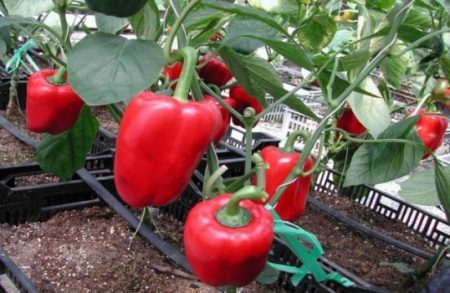 Bulgarian pepper is a member of the nightshade family, America is considered to be the homeland, where until now it can be found in the wild. After spreading to other continents, many fell in love with its fruits, and adapted to grow it in almost all countries of the world. It is eaten fresh, stuffed, added to salads, soups and main dishes. It surpasses even citrus in the content of vitamin C, it also contains other vitamins: B, A, PP.
Bulgarian pepper is a member of the nightshade family, America is considered to be the homeland, where until now it can be found in the wild. After spreading to other continents, many fell in love with its fruits, and adapted to grow it in almost all countries of the world. It is eaten fresh, stuffed, added to salads, soups and main dishes. It surpasses even citrus in the content of vitamin C, it also contains other vitamins: B, A, PP.
Content
General characteristics of the bison variety
An early, highly productive variety of red bell pepper. The height of the bush is not more than 95 cm. The time from seed germination to full ripening is about three months (90-110 days). Cultivation in a temperate and northern climate is produced in a greenhouse, in the southern regions - in open ground. It forms large, fleshy fruits, which weigh on average about 200 g, length up to 20 cm.
Important! Using all agricultural techniques that create favorable conditions for the growth of pepper, you can achieve an unprecedented yield of up to 10 kg / m2. Fruiting is long, up to the first frosts.
Fruits of red color with juicy, crunchy walls, up to 5 mm thick, have an elongated, conical shape, with deep longitudinal grooves.
Growing conditions and care
Cultivation technology is characterized by the following stages:
- Sowing seeds for seedlings is carried out in the month of February, the soil is suitable universal or specialized for peppers and tomatoes.
- Shoots appear on about 7 days, after the appearance of cotyledon leaves it is dived into individual containers.
- In May - June, as the threat of night frost passes, peppers can be planted in open ground, earlier when grown in a greenhouse. Peppers prefer light fertile soil, if it is necessary to lighten it, dig it with the addition of peat, and increase fertility by adding black soil to it.
- After planting, thorough watering is performed, if necessary, excess leaves are removed. Important! The bushes of this variety are quite high, so they need to be tied up, otherwise, under the weight of the fruit, the plant will break and a part of the crop will be lost.
- Throughout the entire period of fruiting, plants must be fed at least 2-3 times.

- Top dressing is carried out for the first time 15-18 days after planting in open ground, for this, 5 g of superphosphate, 10 g of urea are diluted in a bucket of water, and 1 liter of this liquid is poured under each bush.
- The following top dressing occurs during the period of fruit formation: according to the same algorithm, 1 tsp is mixed per bucket of water. potassium and urea with 2 tbsp. superphosphate, water the plants.
- It responds well to feeding the infused young nettle with minerals. Nettle is poured with water, insisted, after a week it starts to ferment, after another couple of days it sinks to the bottom of the bucket. Now it is filtered, mineral fertilizers are added, in accordance with the recommendations of the manufacturers, and each pepper bush is fed.
It is not so difficult to take care of pepper - it requires regular watering, weeding and hilling.
Attention! The distance between adjacent bushes is at least 40 cm, between rows - 80 cm, otherwise each of the plants will interfere with the other, the crop will lack nutrients, which will affect the quantity and quality of the crop.
Diseases Storage rules.
The variety is resistant to diseases characteristic of nightshade. In case of violation of agricultural technology - excessive watering,  rotting of the root system may occur; such plants are removed and burned. The place where it grew is treated with fungicide.
rotting of the root system may occur; such plants are removed and burned. The place where it grew is treated with fungicide.
Pepper itself is not stored for long, you can prolong its freshness by organizing its storage in a cool dark place - a refrigerator or a cellar. To preserve it for the winter, it is frozen or canned either separately or with other vegetables.
Pros and cons of the variety. Reviews gardeners.
Undoubted advantages include:
- seeds are inexpensive, accessible to everyone;
- cultivation in open ground is possible;
- long fruiting period;
- excellent taste;
- large fruits, good presentation (if it is grown for sale);
- easy to carry transportation.
Minuses:
- cultivation in temperate and average climates only in the greenhouse;
- the possibility of breaking the stem due to strong winds and a large number of fruits;
- the need to tie up bushes as they grow.
Zherebtsova Olga Andreyevna, 58 years old:
I grow peppers in my personal plot for a long time, this year I decided to update the varieties, because the old ones have already been shredded and do not produce high yields. A friend advised me to buy red pepper of the Bizon variety, the yield is too painful, she says. I followed her advice. In total, from 5 bushes I gathered so many fruits that it’s enough for both summer and winter. I want to note that ripening occurs gradually, so I ate peppers from the bush until the frost came.
Valery Efimov, 64 years old:
Six years ago, my wife and I bought a house in the village, where, as usual, there is a small garden. So we grew agricultural products for ourselves. Once again, buying seeds at the city market, I noticed a new variety of pepper, I decided to try it. We grew seedlings, transplanted into the ground, tied it up and started ... We could not process this amount of pepper, we began to sell it. So, he liked the villagers that now every year I grow only "Bison" for myself and for sale.




 Calorie pepper stuffed with meat and rice - BZHU per 100 grams
Calorie pepper stuffed with meat and rice - BZHU per 100 grams Gorky pepper - the best varieties for open ground
Gorky pepper - the best varieties for open ground Hot pepper seeds - the best varieties for open ground and reviews
Hot pepper seeds - the best varieties for open ground and reviews Capsicum tincture for hair - how to use and reviews
Capsicum tincture for hair - how to use and reviews